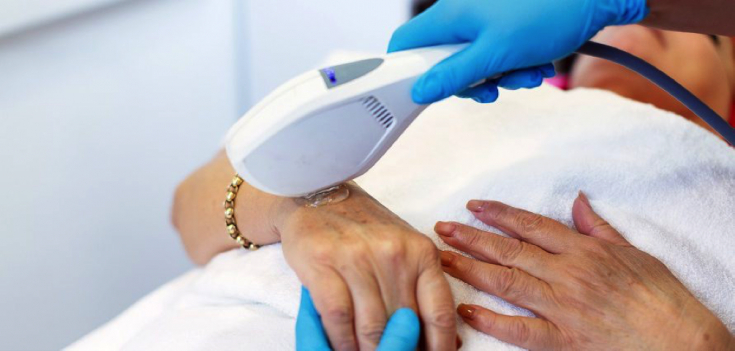Pigmented spots on the hands are more likely to bother older patients. They appear due to intense and / or prolonged exposure to ultraviolet radiation, as well as due to natural aging processes. It is with the lightening of hyperpigmentation that the esthetician Catherine de Goursac begins the process of hand rejuvenation. In his practice, the doctor most often uses chemical peels, lasers and cryotherapy to solve problems with pigmentation of the skin of the hands. In this article, estet-portal.com, a specialist talks about the features of laser removal of hyperpigmentation on the skin of light and dark phototypes.
- Laser removal of pigmentation on the hands: working with skin of phototype I–III phototypes
- Laser removal of pigmentation on the hands: work with skin of IV–VI phototypes
- Risk of post-inflammatory hyperpigmentation after laser therapy
Laser removal of pigmentation on the hands: working with the skin I – III phototypes
To lighten age spots on the hands of owners of I–III Fitzpatrick skin phototypes, two types of lasers are used that work on the principle of ablation or photomechanical stimulation.
Fractional CO2 laser provides partial ablative effect on the skin and is used to treat lentigo or age spots.
The target chromophore of the fractional CO2 laser is water. During laser pigmentation removal, non-contiguous ablation microzones are created, separated by areas of healthy skin. Such partial controlled damage to the skin contributes to its accelerated healing after the procedure.
Subscribe to our channel in Telegram!
Fractional CO2 laser is suitable for lighter skinned patients as it is used on darker phototypes with the risk of rebounding. pigmentation.
Alexandrite laser generates a 755 nm wavelength, which is absorbed by the brown-black pigment eumelanin. Therefore, this device effectively brightens only rather dark pigment spots on the hands.
Due to the intense photomechanical action of the energy of the alexandrite laser, melanin is fragmented into microparticles without an ablative effect on the skin. Subsequently, these microfragments are naturally excreted from the body.
Laser removal of age spots on the hands is carried out on non-tanned skin. After the procedure, effective photoprotection of the skin is required for a period determined by the doctor.
This therapy is ideal for a combination of light skin phototype and pigment spots with a fairly high concentration of melanin.
Red-haired patients produce pheomelanin, which absorbs very little laser energy. Therefore, laser removal of pigmentation for such patients is ineffective.
Laser removal of pigmentation on the hands: working with skin of IV–VI phototypes
For dark phototypes according to Fitzpatrick (IV & ndash;VI), a higher concentration of eumelanin in the skin is characteristic. Due to natural pigmentation, dark skin ages more slowly, but at the same time is more prone to pigmentation disorders than skin of light phototypes. Cases of burns and solar lentigo on dark skin are rare.

In the process of aging, the mechanism of production and distribution of melanin may be disrupted. During exposure to sunlight, skin phototypes IV & VI require adequate photoprotection, which reduces the risk of age spots on the hands and other exposed areas of the body.
Read also: Peculiarities of modern use of laser treatment
To solve the problem of age spots on the skin of dark phototypes, the author uses a new generation laser Nd:YAG with Q-switching. The wavelength of 1064 nm is poorly absorbed by melanin, but allows a deep penetration of the light beam, which destroys the abnormal pigment, while maintaining the natural pigmentation of the skin.
Pigment fragmentation is achieved by photoacoustic (shock waves) and not by thermodynamic action, which can cause an inflammatory response after laser application.
Using incorrect settings during laser pigmentation removal may cause skin burns.
The number of sessions required to obtain the desired results, and the interval between them is determined by the doctor.
Risk of post-inflammatory hyperpigmentation after laser therapy
While Q-switched lasers are considered the standard for pigmentation removal, their use carries a risk of post-inflammatory hyperpigmentation that the patient should be warned about.
Such pigmentation disorders can occur on skin of all types and at any age, but are especially common – in people with dark skin phototypes.
Hyperpigmentation – reactive hypermelanosis that occurs in response to endogenous inflammation, such as acne, atopic and contact dermatitis, or even minimal skin trauma (cuts, insect bites, burns, etc.), or is iatrogenic in nature (for example, in response to laser removal of pigmentation) .
You may also be interested in: Clinical study on the effectiveness of laser for periorbital correction
Typically, this hypermelanosis manifests as hyperpigmented macules that persist for weeks or even months if left untreated.
Laser therapy is not indicated to treat this reaction. On the contrary, pigmentation may increase in response to laser radiation. In such cases, the author prescribes topical depigmenting agents that inhibit melanin synthesis, reducing the severity of age spots.
The basis of such products are:
- vitamin A;
- vitamin C;
- glycolic acid.
Photoprotection – an integral part of hyperpigmentation therapy.
Except in some cases, the author does not prescribe topical corticosteroids because such pigmentation disorders take several weeks to manage and regular application of corticosteroids is associated with risks of skin atrophy.
In order to prevent the appearance of hyperpigmentation, it is necessary to avoid exposure to sunlight and artificial ultraviolet radiation (in solariums) as much as possible, especially for those with light skin phototypes. Effective photoprotection against UVB and UVA through regular use of high
Subscribe to our
YouTube-channel!






